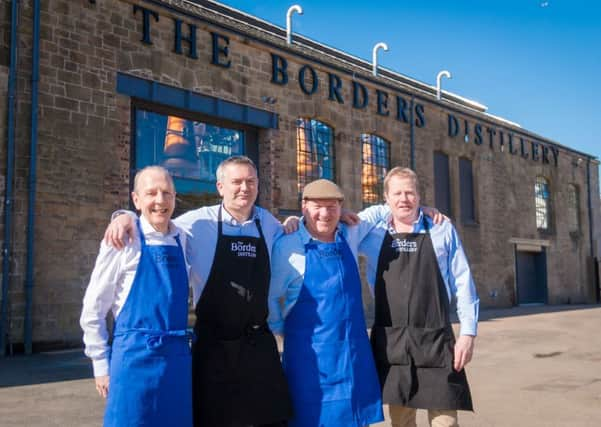Distillery makes dram-atic use '¨of architecture


The building, formerly used by engineering firm Turnbull and Scott – is steeped in history, and the Three Stills Company has ensured that many of the original fixtures have been kept in place or re-used.
The original stonework and metal girders blend beautifully with the modern reception area and shop, and it makes for a stunning renovation.
Advertisement
Hide AdAdvertisement
Hide AdThe £10m project will create up to 19 jobs, and it hopes to attract visitors to the town by offering tours of the facility on the hour, every hour during the day, for £12.
We were given a preview tour of the facility by Tim Carton, one of the founders and chief executive officer at the distillery.
He’s a whisky industry veteran, spending 15 years with William Grant and Sons, where, incidentally, the firm’s other three founders – George Tait, Tony Roberts and John Fordyce – were also employed.
The four founders all have a stake in the operation, though finance also came in the form of a Scottish investment fund, as well as private funding from France and Latin America.
Advertisement
Hide AdAdvertisement
Hide AdTim said there were many good reasons for opening a distillery in the Borders.
He said: “There were some very convincing arguments for us to look to the Scottish Borders for our distillery –the skilled labour market and textile manufacturing history, particularly in tweed and cashmere, were two big influencing factors, as was ready availability of natural resources and raw materials.”
They are taking a strong ethical stance in that as many of the raw ingredients they use are sourced locally – the malted barley that forms the base of the whisky comes from Duns – and that there is a minimumn of waste, with draff from the mash being sent to local farms for cattle fodder, while the pot ale from the stills is sent off to be made into biogas.
THE BUILDING
The site houses two large sheds, dating from 1888, and a Tudor Cotswold building constructed by Hawick Urban Electric Company in 1903.
Advertisement
Hide AdAdvertisement
Hide AdThe company took the decision to preserve as much of the buildings’ historical features in the redevelopment as they could and, under the guidance of GMA Architects and contractor M & J Ballantyne, signs of that sensitive restoration style are evident throughout.
Tim said: “We haven’t gone out of our way to replace or reconfigure the brickwork. We’ve just let the brickwork itself tell the story,
“We were able to take off some of the cladding to reveal the brickwork, which I think is quite beautiful.
“And because it was the Turnbull and Scott’s engineering works, we decided to keep some other features, such as the crane on the roof, although we don’t use it for anything.
Advertisement
Hide AdAdvertisement
Hide Ad“There were also very large steel girders, which we took out and we re-used them as frames and infrastucture in other parts of the building.”
The process
Outside, there are two huge 30-tonne silos full of malted barley.
The grist, the grain separated from the chaff, is put into a mash-tun five tons at a time with water from the distillery’s own boreholes.
In the tun, the temperature is tightly controlled.
Tim said: “If you get it wrong here, it is very wrong by the time it reaches the other end, so this is very important.”
Advertisement
Hide AdAdvertisement
Hide AdThe mash is rinsed three times with hot water in order to maximise the extraction from the malted barley.
Once everything has been extracted, the mash is moved to large fermentation vats, along with 40kg of yeast.
The ‘beer’ comes out, somewhere between 8.5% to 9% alcohol, and put into a wash still, where it is heated again, and the ‘low wine’ comes out at 30%-31%.
It’s then put through a spirit still, and the so-called heart of the spirit is extracted, while the ‘feints’ are then put through another distillation.
Advertisement
Hide AdAdvertisement
Hide AdTim said: “It’s very much a manual distillery, in that we don’t have people sitting behind computers tweaking a mouse.
“Distillers prefer the manual side of it because it gets them more engaged in the process, monitoring things live, up close.
“For the condensers, we draw water from the Teviot as cooling water, and when we put it back into the river, it can be no more than one degree more than when we took it out.
The final spirit, at 70% alcohol, goes into a receiving tank, before being put into casks to be aged in a warehouse just outside town, but some of it goes into a Carterhead still, to make gin, boosted by some locally-sourced botanicals.
Advertisement
Hide AdAdvertisement
Hide AdTim said: “There aren’t too many of these Carterhead stills around. It’s specifically to make white spirits, mainly gin.
“Gin can be made in a couple of weeks, so it’s a good way to bring revenue in earlier.
“Consumers are hugely interested in gin, and they are treating it in a different way to before. It’s much like how people look at malt whisky.
“They are far more appreciative of the nuances between one brand and another.
Advertisement
Hide AdAdvertisement
Hide Ad“And with Scotland having such a great heritage of distilling, why not transfer that into gin?
THE TOUR
A tour of the distillery costs £12, at the end of which, visitors will be able to taste whisky while looking at the distillery’s gallery of photos from when the building was in use by radiator manufacturer Turnbull and Scott.
The whisky needs to be in the casks for at least three years, so the company has developed whiskies in another distillery – Clan Fraser Reserve, a blend of grain and malt, and Lower East Side, a blended malt sourced from the Scottish mainland – in the meantime.